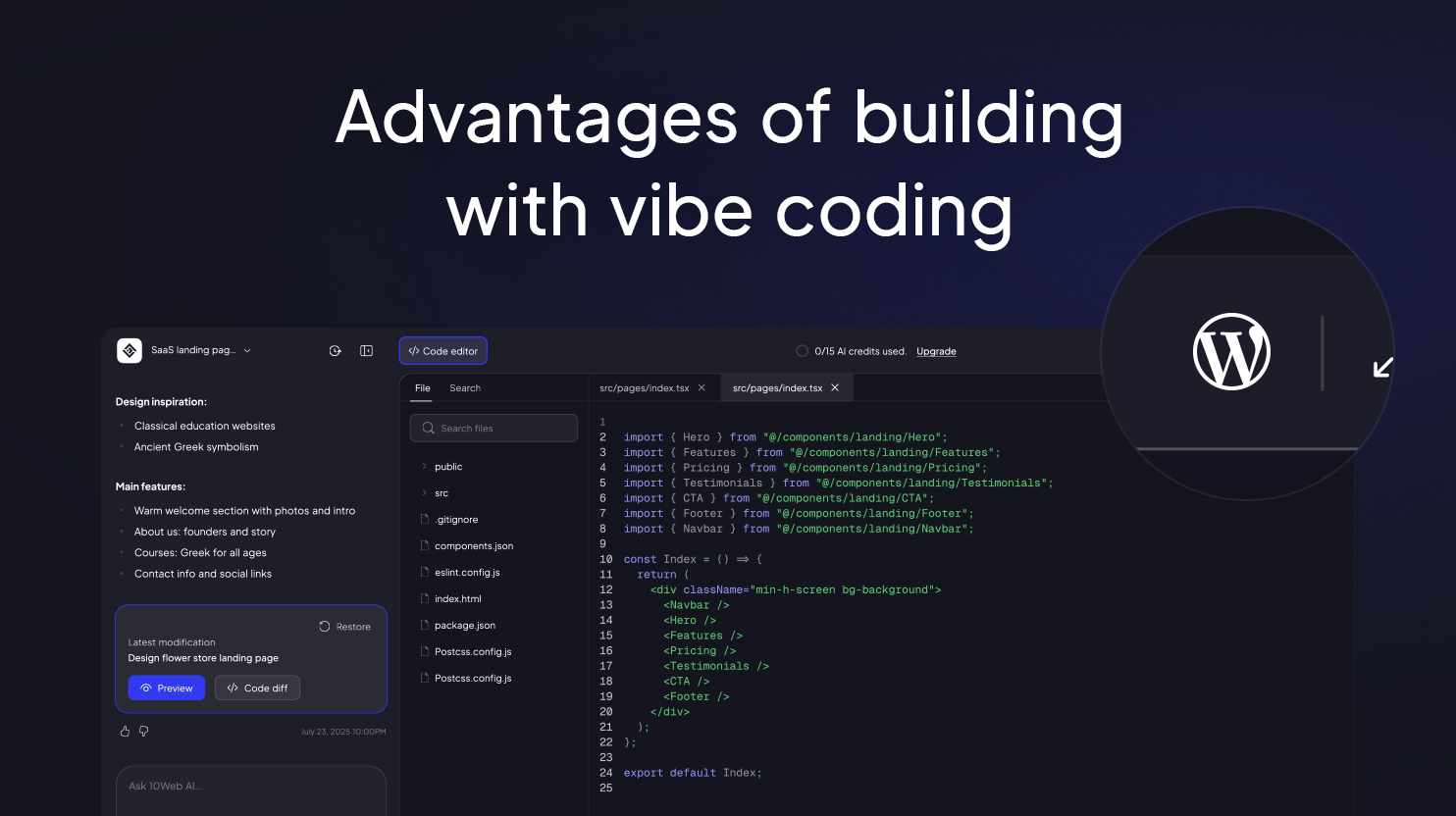Traditional development often moves slowly because it fights on too many fronts: boilerplate, handoffs, context switching, and the “blank screen syndrome.” Lately what’s changed is the new way of coding using natural language called vibe coding. What happens is an AI assistant generates real, reviewable code, and you iterate by prompting. As Andrej Karpathy famously said,
…You fully give in to the vibes, embrace exponentials, and forget that the code even exists.
Vibe coding gives you speed and makes web development accessible to everyone. Paired with a production-ready backend like WordPress, these advantages compound into reliability, governance, and scale. The advantages of vibe coding in software development ensure that you get the fastest path to a ready product with infrastructure and guardrails that make it scalable.
Vibe coding advantages at a glance
- Speed to first value: minutes to an interactive draft.
- Less boilerplate: offload scaffolds, CRUD, wiring, tests.
- Lower barrier: more teammates can safely contribute.
- Rapid iteration: edit by prompt with reviewable diffs.
- Integration velocity: common stacks wired quickly.
- Scale & governance: templates, tokens, PRs, CI, performance budgets.
- WordPress advantage: publish on real infrastructure, not a demo sandbox.
What is vibe coding (and what it isn’t)
Vibe coding is a new way of coding based on describing the outcome you want in plain English. Say you are a potter and you want to create your website. You will need to meet with a developer, tell them how you want to present your product, what you want your site to have, where you want things to be, what functionalities you want (store, order, gallery, book a class…etc), how you want your website to look, so on and so forth.
In the case of vibe coding, you still tell all of this, but to an AI assistant which in turn generates your website or edits the code, you review diffs, run checks, and ship. With traditional web development, a developer would need to write all code by hand.
With vibe coding, unlike no-code builders, you own the code without ever needing to use code. Vibe coding turns natural language into a higher-level interface for building, without removing engineering judgment. Think of it as a force multiplier for people who still care about version control, tests, performance, and security.
Describe your dream site. Watch it come to life.
Vibe code your way to production-ready websites running on the WordPress backend. Zero coding required.
The main advantages of using vibe coding
Though the idea of using English as a coding language has seen some backlash from the engineering community, perhaps not entirely for no reason, but the advantages of vibe coding are numerous.
Speed to first value
One of the biggest wins is time. With vibe coding you can get from an idea to an interactive draft in minutes. That shortens feedback loops dramatically, allowing you to refine based on real reactions instead of guessing. On WordPress, that draft isn’t a mock server; it’s a staging site with SSL/CDN and a real URL your team can share.
What this unlocks
- Earlier buy-in for product direction.
- Cheaper changes while everything is still fluid.
- Fewer meetings about hypotheticals; more decisions from live previews.
Massive reduction in boilerplate
Boilerplate is time consuming. CRUD, routes, state, validation, tests, configs, it’s the boring part of the work that kills momentum. Vibe coding auto-scaffolds the guts (components, bound forms, list/detail patterns, a11y), and on WordPress it drops right into blocks, CPTs, taxonomies, roles, and vetted plugins. Users get to focus on the real work: logic, UX, and performance.
What this unlocks
- More time for the hard parts: data modeling, edge cases, and polish.
- Consistent patterns across projects.
- Lower ramp-up cost for new contributors.
Rapid iteration and safer edits
Refactors can normally feel risky. Changing something in one place means you need to repeat that throughout your code. Renaming a component used in many places, switching design tokens, or re-threading a flow becomes manageable with vibe coding.
Ask the assistant to propose changes across files, review diffs, and merge. Because you’re operating on code under version control, every change is traceable and reversible. In WordPress contexts, this means you can restyle sections, regenerate blocks, or adjust CPTs without breaking templates or losing editorial content.
What this unlocks
- Confident experiments: try two layout options in parallel.
- Global refreshes in hours, not days.
- Fewer regressions due to consistent edits.
Faster integrations
Vibe coding accelerates integrations with pre-wired patterns that you can then review and harden. On WordPress, that equals known-good stacks, WooCommerce, Stripe, membership gating, CRM forms, SEO schema, wired by recipe. You’re starting from a working baseline and applying your policies on top.
What this unlocks
- Reduced integration time from days to hours.
- More consistent security and data flows.
- Clearer handoffs to ops and support.
Scale: from one site to many
Once a set of prompts reliably generates quality scaffolds, you can templatize them into industry packs, brand kits, component libraries, token sets, and scale up ten or a hundred variants with consistency. Global updates become simplified: update a token or component once and propagate. For agencies and internal platform teams, this is the difference between huge effort and routine delivery.
What this unlocks
- Repeatable blueprints for common verticals.
- Multi-site or white-label production with controlled variance.
- Measurable throughput gains without sacrificing quality.
Why WordPress amplifies the benefits of vibe coding
The WordPress backend provides production-ready building blocks that vibe coding can utilize instantly, giving it the perfect backend to scale:
- Mature ecosystem: plugins for commerce, auth, search, media, SEO, and more.
- Editorial workflows: roles/capabilities, revisions, scheduled publishing, media management.
- Operational readiness: managed hosting, SSL, CDN, backups, monitoring, updates.
- Auditability and control: you own the code; use PRs, CI, rollbacks, and dependency policies.
- Performance and SEO: caching layers, image optimization, schema, and Core Web Vitals guidance baked into the pipeline.
Vibe for WordPress
Vibe for WordPress is 10Web’s AI-native frontend builder fully integrated with the WordPress backend. It merges vibe coding freedom with the reliability and scale of the world’s leading CMS within a 360 degree ecosystem that covers everything starting with managed WordPress hosting all the way to a variety of B2B and White Label solutions.
Vibe for WordPress works similar to other vibe tools in the market. Describe what you want, and it generates clean, editable WordPress code in minutes. It’s prompt-to-production on the world’s most battle-tested and used CMS. You chat, it codes, then you iterate by chat. Click to choose which section to edit and continue to chat to code. Developers review diffs, designers refine visuals, and content teams work directly in WordPress, with hosting, SSL, CDN, and plugins handled automatically. 10Web has the entire ecosystem.
What teams report
- Minutes to a first staging URL.
- Sections that are WooCommerce-ready and SEO-aware from the start.
- Safer iterations: diffs are readable, tests are generated, budgets are checked.
- Large professional support and community.

Describe your dream site. Watch it come to life.
Vibe code your way to production-ready websites running on the WordPress backend. Zero coding required.
Turning vibe coding advantages into a working pipeline
- Capture intent clearly. Include brand tokens (typography, colors), content model (entities, fields), acceptance criteria (performance, accessibility, SEO), and integrations (payments, forms, email).
- Generate the scaffold. Produce components/blocks, CPTs/taxonomies, routes, basic tests, and instrumentation.
- Inspect diffs like an engineer. Enforce PR reviews, linting, type checks, a11y audits, and performance budgets.
- Connect integrations. Bring in commerce, membership, forms, search, and analytics from a vetted list.
- Stage on WordPress. Publish a real staging URL with SSL/CDN, role-based access, and backups.
- Iterate by prompt. Apply refactors and restyles; re-run checks; merge when budgets pass.
- Template what works. Save winning prompts as reusable recipes; ship the next site faster.
Closing thoughts
Vibe coding brings to the table a new way of working for a much larger audience. Using natural language to collaborate with an AI that understands your intent and then translates it into usable and scalable code is at its beginning stages. It seems as though technology has been bound to go in this direction since the first AI-assisted building tools.
When combined with a strong backend like WordPress, developers gain speed and control, non-technical users get accessibility, and businesses unlock scalable delivery and recurring value. As more professionals experiment with AI-assisted workflows, Vibe for WordPress stands out as the bridge between creativity and code, fast, flexible, and built for the real web.
FAQ
How is vibe coding different from no-code or low-code tools?
Unlike no-code builders, vibe coding generates real code you can inspect, edit, and deploy. You describe what you want in plain language, and the AI writes structured, reviewable code.
What are the main advantages for agencies or teams with 10Webs Vibe for WordPress?
Faster delivery (minutes to first staging), reusable templates, reduced boilerplate, safer edits, and scalability across multiple sites, all while keeping full code ownership and creative control.
Can vibe coding replace developers?
No. It speeds up development by handling repetitive or boilerplate tasks, but human oversight is essential for architecture, logic, security, and performance.
Why pair vibe coding with WordPress?
WordPress provides a production-ready backend with plugins, SEO tools, and hosting infrastructure, meaning vibe-generated sites are instantly deployable and scalable, not just demos.











